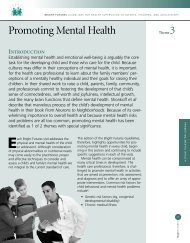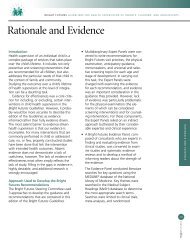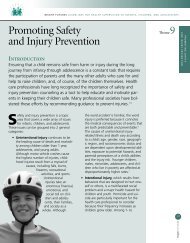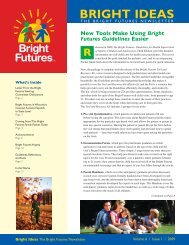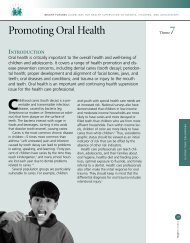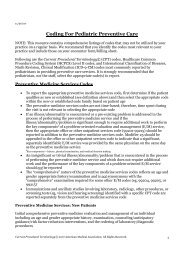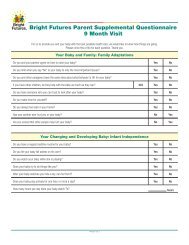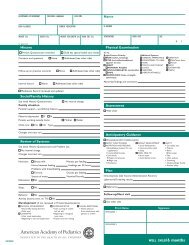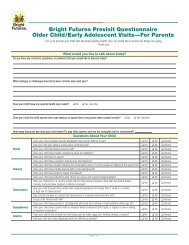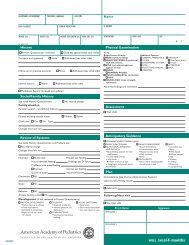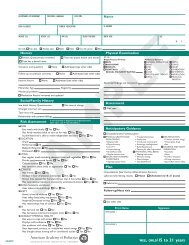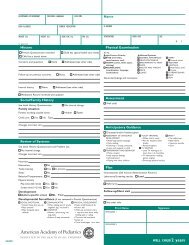POCKET GUIDE - Bright Futures - American Academy of Pediatrics
POCKET GUIDE - Bright Futures - American Academy of Pediatrics
POCKET GUIDE - Bright Futures - American Academy of Pediatrics
You also want an ePaper? Increase the reach of your titles
YUMPU automatically turns print PDFs into web optimized ePapers that Google loves.
Anticipatory Guidance<br />
discuss with Parents<br />
parent-Child Feeding relationship<br />
■ Purchasing and preparing nutritious food.<br />
■ <strong>of</strong>fering developmentally appropriate, healthy meals and<br />
snacks at scheduled times in a pleasant environment.<br />
■ helping their child develop eating and self-serving skills<br />
(progressing from using hands for eating to using utensils).<br />
■ helping their child learn to self-regulate food intake by<br />
responding to internal cues <strong>of</strong> hunger and fullness.<br />
■ Allowing their child to decide whether to eat and how<br />
much.<br />
Meals and snacks<br />
■ <strong>of</strong>fering healthy food choices at meals and snacks served<br />
at about the same time each day.<br />
■ <strong>of</strong>fering nutritious foods (whole-grain crackers, milk<br />
and milk products, fruits, vegetables, meat or poultry)<br />
as snacks because children <strong>of</strong>ten eat small amounts <strong>of</strong><br />
food at one time.<br />
■ sharing meals and snacks with their child. (Children eat<br />
better when an adult is nearby.)<br />
■ Being positive role models by eating new foods.<br />
■ Making family mealtimes a priority, and getting rid <strong>of</strong><br />
distractions (television).<br />
■ Being patient and understanding as their child learns to<br />
feed or serve herself.<br />
■ <strong>of</strong>fering small portions (1 or 2 tablespoons) <strong>of</strong> new foods.<br />
■ Not using foods to reward, bribe, or punish their child or<br />
to calm, comfort, or entertain her.<br />
■ <strong>of</strong>fering dessert (custard, pudding, fruits, yogurt) as part<br />
<strong>of</strong> a meal.<br />
eating<br />
■ Weaning their child from the bottle by age 12 to<br />
14 months.<br />
■ Modifying foods to make them easier for their child to eat.<br />
■ helping children ages 2 to 5 gradually decrease their<br />
fat intake.<br />
■ serving children ages 1 to 2 whole milk (serving reducedfat<br />
[2%] milk if obesity is <strong>of</strong> concern or if there is a family<br />
history <strong>of</strong> obesity, dyslipidemia, or cardiovascular disease).<br />
■ serving children older than age 2 low-fat (1%) or fat-free<br />
(skim) milk.<br />
■ serving children ages 2 and older 2 servings <strong>of</strong> milk<br />
(two 8-oz cups) per day.<br />
29<br />
<strong>Bright</strong> FUTURES<br />
Early Childhood



